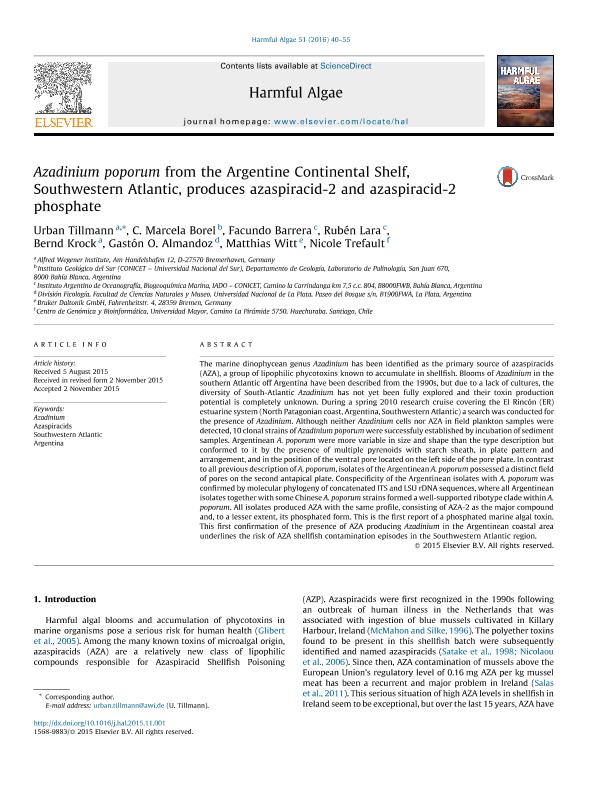Mostrar el registro sencillo del ítem
dc.contributor.author
Tillmann, Urban
dc.contributor.author
Borel, Claudia Marcela

dc.contributor.author
Barrera, Facundo Matías

dc.contributor.author
Lara, Ruben Jose

dc.contributor.author
Krock, Bernd
dc.contributor.author
Almandoz, Gaston Osvaldo

dc.contributor.author
Witt, Matthias
dc.contributor.author
Trefault, Nicole
dc.date.available
2017-09-27T16:26:09Z
dc.date.issued
2016-01
dc.identifier.citation
Tillmann, Urban; Borel, Claudia Marcela; Barrera, Facundo Matías; Lara, Ruben Jose; Krock, Bernd; et al.; Azadinium poporum from the Argentine Continental Shelf, Southwestern Atlantic, produces azaspiracid-2 and azaspiracid-2 phosphate; Elsevier Science; Harmful Algae; 51; 1-2016; 40-55
dc.identifier.issn
1568-9883
dc.identifier.uri
http://hdl.handle.net/11336/25223
dc.description.abstract
The marine dinophycean genus Azadinium has been identified as the primary source of azaspiracids (AZA), a group of lipophilic phycotoxins known to accumulate in shellfish. Blooms of Azadinium in the southern Atlantic off Argentina have been described from the 1990s, but due to a lack of cultures, the diversity of South-Atlantic Azadinium has not yet been fully explored and their toxin production potential is completely unknown. During a spring 2010 research cruise covering the El Rinco´n (ER) estuarine system (North Patagonian coast, Argentina, Southwestern Atlantic) a search was conducted for the presence of Azadinium. Although neither Azadinium cells nor AZA in field plankton samples were detected, 10 clonal strains of Azadinium poporum were successfuly established by incubation of sediment samples. Argentinean A. poporum were more variable in size and shape than the type description but conformed to it by the presence of multiple pyrenoids with starch sheath, in plate pattern and arrangement, and in the position of the ventral pore located on the left side of the pore plate. In contrast to all previous description of A. poporum, isolates of the Argentinean A. poporum possessed a distinct field of pores on the second antapical plate. Conspecificity of the Argentinean isolates with A. poporum was confirmed by molecular phylogeny of concatenated ITS and LSU rDNA sequences, where all Argentinean isolates together with some Chinese A. poporum strains formed a well-supported ribotype clade within A. poporum. All isolates produced AZA with the same profile, consisting of AZA-2 as the major compound and, to a lesser extent, its phosphated form. This is the first report of a phosphated marine algal toxin. This first confirmation of the presence of AZA producing Azadinium in the Argentinean coastal area underlines the risk of AZA shellfish contamination episodes in the Southwestern Atlantic region.
dc.format
application/pdf
dc.language.iso
eng
dc.publisher
Elsevier Science

dc.rights
info:eu-repo/semantics/openAccess
dc.rights.uri
https://creativecommons.org/licenses/by-nc-sa/2.5/ar/
dc.subject
Azadinium
dc.subject
Azaspiracids
dc.subject
Southwestern Atlantic
dc.subject
Argentina
dc.subject
Azaspiracids
dc.subject
Argentina
dc.subject.classification
Oceanografía, Hidrología, Recursos Hídricos

dc.subject.classification
Ciencias de la Tierra y relacionadas con el Medio Ambiente

dc.subject.classification
CIENCIAS NATURALES Y EXACTAS

dc.title
Azadinium poporum from the Argentine Continental Shelf, Southwestern Atlantic, produces azaspiracid-2 and azaspiracid-2 phosphate
dc.type
info:eu-repo/semantics/article
dc.type
info:ar-repo/semantics/artículo
dc.type
info:eu-repo/semantics/publishedVersion
dc.date.updated
2017-08-08T14:38:46Z
dc.journal.volume
51
dc.journal.pagination
40-55
dc.journal.pais
Países Bajos

dc.journal.ciudad
Amsterdam
dc.description.fil
Fil: Tillmann, Urban. Alfred Wegener Institute; Alemania
dc.description.fil
Fil: Borel, Claudia Marcela. Consejo Nacional de Investigaciones Científicas y Técnicas. Centro Científico Tecnológico Conicet - Bahía Blanca. Instituto Geológico del Sur. Universidad Nacional del Sur. Departamento de Geología. Instituto Geológico del Sur; Argentina
dc.description.fil
Fil: Barrera, Facundo Matías. Consejo Nacional de Investigaciones Científicas y Técnicas. Centro Científico Tecnológico Conicet - Bahía Blanca. Instituto Argentino de Oceanografía. Universidad Nacional del Sur. Instituto Argentino de Oceanografía; Argentina
dc.description.fil
Fil: Lara, Ruben Jose. Consejo Nacional de Investigaciones Científicas y Técnicas. Centro Científico Tecnológico Conicet - Bahía Blanca. Instituto Argentino de Oceanografía. Universidad Nacional del Sur. Instituto Argentino de Oceanografía; Argentina
dc.description.fil
Fil: Krock, Bernd. Alfred Wegener Institute; Alemania
dc.description.fil
Fil: Almandoz, Gaston Osvaldo. Universidad Nacional de la Plata. Facultad de Ciencias Naturales y Museo. Division Ficologia; Argentina
dc.description.fil
Fil: Witt, Matthias. Bruker Daltonik Gmbh; Alemania
dc.description.fil
Fil: Trefault, Nicole. Universidad Mayor. Centro de Genómica y Bioinformática; Chile
dc.journal.title
Harmful Algae

dc.relation.alternativeid
info:eu-repo/semantics/altIdentifier/doi/http://dx.doi.org/10.1016/j.hal.2015.11.001
dc.relation.alternativeid
info:eu-repo/semantics/altIdentifier/url/http://www.sciencedirect.com/science/article/pii/S1568988315300731
Archivos asociados
